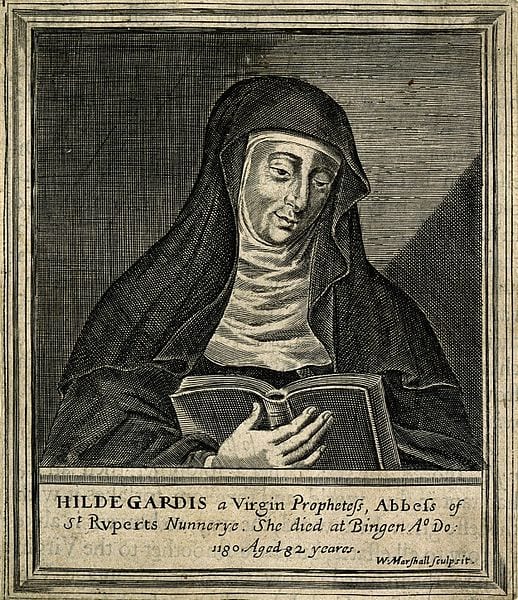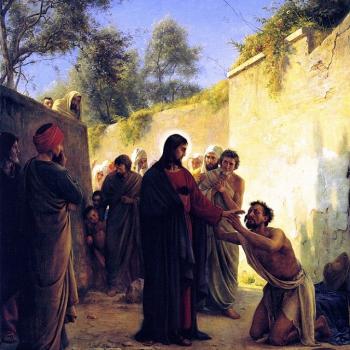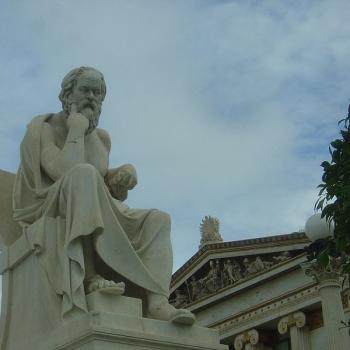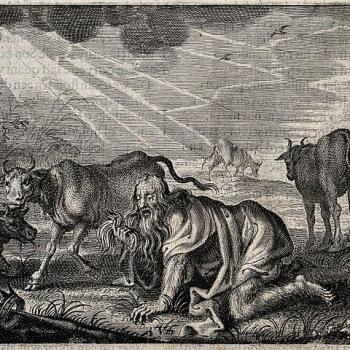
Atheist and anti-theist Bob Seidensticker, who was “raised Presbyterian”, runs the influential Cross Examined blog. He asked me there, on 8-11-18: “I’ve got 1000+ posts here attacking your worldview. You just going to let that stand? Or could you present a helpful new perspective that I’ve ignored on one or two of those posts?” He added in June 2017 in a combox: “If I’ve misunderstood the Christian position or Christian arguments, point that out. Show me where I’ve mischaracterized them.” Delighted to oblige his wishes . . .
Bob (for the record) virtually begged and pleaded with me to dialogue with him in May 2018, via email. But by 10-3-18, following massive, childish name-calling attacks against me, encouraged by Bob on his blog, he banned me from commenting there. I also banned him for violation of my rules for discussion, but (unlike him) provided detailed reasons for why it was justified.
Bob’s cowardly hypocrisy knows no bounds. On 6-30-19, he was chiding someone for something very much like his own behavior: “Spoken like a true weasel trying to run away from a previous argument. You know, you could just say, ‘Let me retract my previous statement of X’ or something like that.” Yeah, Bob could! He still hasn’t yet uttered one peep in reply to — now — 58 of my critiques of his atrocious reasoning.
Bible-Basher Bob reiterated and rationalized his intellectual cowardice yet again on 10-17-20: “Every engagement with him [yours truly] devolves into pointlessness. I don’t believe I’ve ever learned anything from him. But if you find a compelling argument of his, summarize it for us.” And again the next day: “He has certainly not earned a spot in my heart, so I will pass on funding his evidence-free project. Like you, I also find that he’s frustrating to talk with. Again, I evaluate such conversations as useful if I can learn something–find a mistake in my argument, uncover an error I made in Christians’ worldview, and so on. Dave is good at bluster, and that’s about it.”
Bible-Basher Bob’s words will be in blue. To find these posts, follow this link: “Seidensticker Folly #” or see all of them linked under his own section on my Atheism page.
*****
The following is a critique of Bob’s article, “Yeah, but Christianity Built Hospitals!” (4-22-20; update of 2-6-16).
Many Christians will point to medieval hospitals to argue that they were pioneers in giving us the medical system that we know today. Let’s consider that claim. . . .
Health care in the Bible
We can look to the Bible to see where Christian contributions to medical science come from.
We find Old Testament apotropaic medicine (medicine to ward off evil) in Numbers 21:5–9. When God grew tired of the Israelites whining about harsh conditions during the Exodus, he sent poisonous snakes to bite them. As a remedy, God told Moses to make a bronze snake (the Nehushtan). This didn’t get rid of the snakes or the snake bites, but it did mean that anyone who looked at it after being bitten would magically live. So praise the Lord, I guess.
This is a “hair of the dog” type of treatment, akin to modern homeopathic “medicine.” Just as bronze snake statues are useless as medicine today, Jesus and his ideas of disease as a manifestation of demon possession was also useless.
This is an absurdly simplistic, jaded, and cynically selective (i.e., intellectually dishonest) treatment of the Bible’s approach to medicine and health care (which is far more sophisticated, rightly understood). I have dealt with this (specifically or generally, with regard to larger science) at length, in reply to Bob and a similar Bible-bashing atheist, Dr. David Madison:
Seidensticker Folly #21: Atheist “Bible Science” Absurdities [9-25-18]
Seidensticker Folly #23: Atheist “Bible Science” Inanities, Pt. 2 [10-2-18]
Vs. Atheist David Madison #37: Bible, Science, & Germs [12-10-19]
Seidensticker Folly #36: Disease, Jesus, Paul, Miracles, & Demons [1-13-20]
Seidensticker Folly #44: Historic Christianity & Science [8-29-20]
See many many more articles on Christianity and science on my Atheism and Science web pages, as well as my book, Science and Christianity: Close Partners or Mortal Enemies?. And of course, it’s common knowledge (at least among fair-minded, objective thinkers) that when both modern science and modern medicine got off the ground, starting in the 15th or 16th centuries, Christian scientists were in the forefront, and remained so till the massive secularization of science after Darwin in the 19th century. Christianity is the furthest thing from “antithetical” to science: much as thick-skulled atheist anti-theists like Bob vainly wish it were otherwise, for their polemical purposes.
The Father of Western Medicine was Hippocrates, not Jesus.
This is irrelevant, as Jesus never claimed to be the father of medicine in the first place. But since Hippocrates was brought up, I have written in my treatment of the Bible and germs and infectious disease:
Hippocrates, the pagan Greek “father of medicine” didn’t understand the causes of contagious disease. Nor did medical science until the 19th century. But the hygienic principles that would have prevented the spread of such diseases were in the Bible: in the Laws of Moses. . . .
Hippocrates, the “father of medicine” (born 460 BC), thought “bad air” from swampy areas was the cause of disease.
Mosaic Law and Hebrew hygienic practices, dating as far back as some 800 years before Hippocrates, were far more advanced:
1. The Bible contained instructions for the Israelites to wash their bodies and clothes in running water if they had a discharge, came in contact with someone else’s discharge, or had touched a dead body. They were also instructed about objects that had come into contact with dead things, and about purifying items with an unknown history with either fire or running water. They were also taught to bury human waste outside the camp, and to burn animal waste (Num 19:3-22;Lev. 11:1-47; 15:1-33;Deut 23:12).
2. Leviticus 13 and 14 mention leprosy on walls and on garments. Leprosy is a bacterial disease, and can survive for three weeks or longer apart from the human body. Thus, God commanded that the garments of leprosy victims should be burned (Lev 13:52).
3. It was not until 1873 that leprosy was shown to be an infectious disease rather than hereditary. Of course, the laws of Moses already were aware of that (Lev 13, 14, 22; Num 19:20). It contains instructions about quarantine and about quarantined persons needing to thoroughly shave and wash. Priests who cared for them also were instructed to change their clothes and wash thoroughly. The Israelites were the only culture to practice quarantine until the 19th century, when medical advances discovered the biblical medical principles and practices.
Medieval hospitals
Without science, a hospital can do nothing but provide food and comfort. Palliative care is certainly something, and let’s celebrate whatever comfort was provided by church-supported hospitals, but these medieval European institutions were little more than almshouses or places to die—think hospitals without the science.
Christian medicine did not advance past that of Galen, the Greek physician of 2nd century who wrote medical texts and whose theories dominated Western Christian medicine for over 1300 years. Not until the 1530s (during the Renaissance) did the physician Andreas Vesalius surpass Galen in the area of human anatomy.
First of all, I must note the silly outlook of Bob on this issue of medical advancement. If Christianity rejects anything in learning from pagan predecessors, then we catch hell. But as serious historians know, Christianity did not do any such thing. In fact, it was in the forefront in preserving manuscripts from classical Greek and Roman learning, which it revered. Some of it was lost in some places, and for considerable lengths of time, but that was almost solely due to pagan barbarian invasions and antipathy to learning, not Christianity per se. Historians have long since abandoned antiquated, anti-Catholic notions of the “Dark Ages.”
On the other hand, if and when Christianity follows pagan learning and practices (as with medicine and Galen), then we are bashed for simply following precedent and not developing it further. This is downright silly. All knowledge — from whatever source — is good and ought to be gratefully and respectfully accepted and incorporated into any future advances of knowledge. Galen was followed by Christians because his knowledge was the best for his time and no one surpassed it for a long time after. Even Bob (almost despite himself) notes that “Galen’s] theories dominated Western Christian medicine for over 1300 years.” Okay; then give Christianity credit for following his science! That’s obviously neither “anti-science” nor “anti-pagan learning” is it?
I’d like to give credit where it’s due. If the medieval Church catalyzed human compassion into hospitals that wouldn’t have been there otherwise, that’s great, . . .
And I sincerely give Bob credit and thank him for giving medieval Christianity at least some credit.
We can get a picture of medieval Christian hospitals by looking at Mother Teresa’s Missionaries of Charity hospitals. They have minor comforts, and at best they are comfortable places to die. They’re not meant for treating disease . . .
Did Christianity retard medical science with its anti-science attitude? We forget how long a road it was to reach our modern medical understanding. The book Bad Medicine argues that “until the invention of antibiotics in the 1930s doctors, in general, did their patients more harm than good.” Christianity might have set modern medical science back centuries.
Here we get to the heart of what I will object to in Bob’s article. I would like to explore how Christians in the Middle Ages, in the hospitals that they spearheaded, did have treatments, and did make positive efforts to cure their patients: contrary to Bob’s cynical caricatures. Surely by today’s standards, whatever science was present was primitive, and was — without question — mixed with well-intentioned errors. But the latter is nothing new. Even the first “modern scientists” had many false views incorporated within their worldviews, such as alchemy and astrology. Nor was subsequent science, even up to the 20th century, immune from foolish errors. Christianity by no means has a lock on (inexcusable?) errors.
But let’s look at what these medieval hospitals were positively doing; what they did know, by way of medicinal and therapeutic treatments. It’s not true that they were “anti-science” or were “not meant for treating disease.” These are lies. Even in the following article that expresses the usual hostile (and ultra-biased) attitudes towards medieval Christianity, the use of various herbal treatments couldn’t be ignored:
Medicinal plants and herbs were an important and major part in the pharmacopeia. Medicines were made from herbs, spices, and resins. Dioscorides, a Greek, wrote his Materia Medica in 65 AD. This was a practical text dealing with the medicinal use of more than 600 plants in the second century. Although the original text of Dioscorides is lost, there are many surviving copies. His texts formed the basis of much of the herbal medicine practiced until 1500 . Some plants were used for specific disorders, while others were credited with curing multiple diseases. In many cases, preparations were made of many different herbs. . . .
[I]n the Middle Ages, the study of medicinal plants was in the hands of monks who in their monasteries planted and experimented on the species described in classic texts. [Dave: this scenario — let’s not forget — produced Mendel, who discovered genetics] No monastic garden would have been complete without medicinal plants. The sick went to the monastery, local herbalist, or apothecary to obtain healing herbs. Most monasteries developed herb gardens for use in the production of herbal cures, and these remained a part of folk medicine, as well as were being used by some professional physicians. Books of herbal remedies were produced by monks as many monks were skilled at producing books and manuscripts and tending both medicinal gardens and the sick. . . .
Headache and aching joints were treated with sweet-smelling herbs such as rose, lavender, sage, and hay. A mixture of henbane and hemlock was applied to aching joints. Coriander was used to reduce fever. Stomach pains and sickness were treated with wormwood, mint, and balm. Lung problems were treated with a medicine made of liquorice and comfrey. Cough syrups and drinks were prescribed for chest and head-colds and coughs. Wounds were cleaned and vinegar was widely used as a cleansing agent as it was believed that it would kill disease. Mint was used in treating venom and wounds. Myrrh was used as an antiseptic on wounds. (“The Air of History (Part II) Medicine in the Middle Ages”; Rachel Hajar, MD; Heart Views. 2012 Oct-Dec; 13(4): 158–162)
That’s far from “not treating disease” at all, isn’t it? Therefore, Bob has presented biased anti-Christian slop once again. He made no effort to actually do research and investigate the issue. It’s not his purpose. He has to run down Christianity. That’s what he lives for.
The Wikipedia article, “Medieval medicine of Western Europe” examines these issues in infinitely more depth than Bob does. No one could read it and come away with Bob’s stunted, warped, prejudiced outlook on the topic. Bob clearly has no idea what he is talking about. He’s like a three-year-old lecturing on quantum mechanics or calculus: clearly over his head. Here are some excerpts:
The practice of medicine in the early Middle Ages was empirical and pragmatic. It focused mainly on curing disease rather than discovering the cause of diseases. Often it was believed the cause of disease was supernatural. Nevertheless, secular approaches to curing diseases existed. . . .
Folk medicine of the Middle Ages dealt with the use of herbal remedies for ailments. The practice of keeping physic gardens teeming with various herbs with medicinal properties was influenced by the gardens of Roman antiquity. Many early medieval manuscripts have been noted for containing practical descriptions for the use of herbal remedies. These texts, such as the Pseudo-Apuleius, included illustrations of various plants that would have been easily identifiable and familiar to Europeans at the time. Monasteries later became centres of medical practice in the Middle Ages, and carried on the tradition of maintaining medicinal gardens. . . .
Hildegard of Bingen was an example of a medieval medical practitioner while educated in classical Greek medicine, also utilized folk medicine remedies. Her understanding of the plant based medicines informed her commentary on the humors of the body and the remedies she described in her medical text Causae et curae were influenced by her familiarity with folk treatments of disease. . . . Kitchens were stocked with herbs and other substances required in folk remedies for many ailments. Causae et curae illustrated a view of symbiosis of the body and nature, that the understanding of nature could inform medical treatment of the body. . . .
Evidence of pagan influence on emerging Christian medical practice was provided by many prominent early Christian thinkers, such as Origen, Clement of Alexandria, and Augustine, who studied natural philosophy and held important aspects of secular Greek philosophy that were in line with Christian thought. . . .
Herbal remedies, known as Herbals, along with prayer and other religious rituals were used in treatment by the monks and nuns of the monasteries. Herbs were seen by the monks and nuns as one of God’s creations for the natural aid that contributed to the spiritual healing of the sick individual. An herbal textual tradition also developed in the medieval monasteries. Older herbal Latin texts were translated and also expanded in the monasteries. The monks and nuns reorganized older texts so that they could be utilized more efficiently, adding a table of contents for example to help find information quickly. Not only did they reorganize existing texts, but they also added or eliminated information. New herbs that were discovered to be useful or specific herbs that were known in a particular geographic area were added. Herbs that proved to be ineffective were eliminated. Drawings were also added or modified in order for the reader to effectively identify the herb. The Herbals that were being translated and modified in the monasteries were some of the first medical texts produced and used in medical practice in the Middle Ages.
Not only were herbal texts being produced, but also other medieval texts that discussed the importance of the humors. Monasteries in Medieval Europe gained access to Greek medical works by the middle of the 6th century. Monks translated these works into Latin, after which they were gradually disseminated across Europe. Monks such as Arnald of Villanova also translated the works of Galen and other classical Greek scholars from Arabic to Latin during the Medieval ages. By producing these texts and translating them into Latin, Christian monks both preserved classical Greek medical information and allowed for its use by European medical practitioners. By the early 1300s these translated works would become available at medieval universities and form the foundation of the universities medical teaching programs. . . .
In exchanging the herbal texts among monasteries, monks became aware of herbs that could be very useful but were not found in the surrounding area. The monastic clergy traded with one another or used commercial means to obtain the foreign herbs. Inside most of the monastery grounds there had been a separate garden designated for the plants that were needed for the treatment of the sick. A serving plan of St. Gall depicts a separate garden to be developed for strictly medical herbals. Monks and nuns also devoted a large amount of their time in the cultivation of the herbs they felt were necessary in the care of the sick. Some plants were not native to the local area and needed special care to be kept alive. The monks used a form of science, what we would today consider botany, to cultivate these plants. Foreign herbs and plants determined to be highly valuable were grown in gardens in close proximity to the monastery in order for the monastic clergy to hastily have access to the natural remedies.
Medicine in the monasteries was concentrated on assisting the individual to return to normal health. Being able to identify symptoms and remedies was the primary focus. In some instances identifying the symptoms led the monastic clergy to have to take into consideration the cause of the illness in order to implement a solution. Research and experimental processes were continuously being implemented in monasteries to be able to successfully fulfill their duties to God to take care of all God’s people. . . .
Medieval European medicine became more developed during the Renaissance of the 12th century, when many medical texts both on Ancient Greek medicine and on Islamic medicine were translated from Arabic during the 13th century. The most influential among these texts was Avicenna‘s The Canon of Medicine, a medical encyclopedia written in circa 1030 which summarized the medicine of Greek, Indian and Muslim physicians until that time. The Canon became an authoritative text in European medical education until the early modern period. Other influential texts from Jewish authors include the Liber pantegni by Isaac Israeli ben Solomon, while Arabic authors contributed De Gradibus by Alkindus and Al-Tasrif‘ by Abulcasis.
At Schola Medica Salernitana in Southern Italy, medical texts from Byzantium and the Arab world (see Medicine in medieval Islam) were readily available, translated from the Greek and Arabic at the nearby monastic centre of Monte Cassino. The Salernitan masters gradually established a canon of writings, known as the ars medicinae (art of medicine) or articella (little art), which became the basis of European medical education for several centuries. . . .
In Paris, in the late thirteenth century, it was deemed that surgical practices were extremely disorganized, and so the Parisian provost decided to enlist six of the most trustworthy and experienced surgeons and have them assess the performance of other surgeons. The emergence of universities allowed for surgery to be a discipline that should be learned and be communicated to others as a uniform practice. The University of Padua was one of the “leading Italian universities in teaching medicine, identification and treating of diseases and ailments, specializing in autopsies and workings of the body.” The most prestigious and famous part of the university is the oldest surviving anatomical theater, in which students studied anatomy by observing their teachers perform public dissections.
Surgery was formally taught in Italy even though it was initially looked down upon as a lower form of medicine. The most important figure of the formal learning of surgery was Guy de Chauliac. [c. 1300-1368]. He insisted that a proper surgeon should have a specific knowledge of the human body such as anatomy, food and diet of the patient, and other ailments that may have affected the patients. . . .
The Middle Ages contributed a great deal to medical knowledge. This period contained progress in surgery, medical chemistry, dissection, and practical medicine. The Middle Ages laid the ground work for later, more significant discoveries. There was a slow but constant progression in the way that medicine was studied and practiced. It went from apprenticeships to universities and from oral traditions to documenting texts. The most well-known preservers of texts, not only medical, would be the monasteries. The monks were able to copy and revise any medical texts that they were able to obtain. . . .
Roger Frugardi of Parma composed his treatise on Surgery around about 1180. Between 1250 and 1265 Theodoric Borgognoni produced a systematic four volume treatise on surgery, the Cyrurgia, which promoted important innovations as well as early forms of antiseptic practice in the treatment of injury, and surgical anaesthesia using a mixture of opiates and herbs.
Compendiums like Bald’s Leechbook (circa 900), include citations from a variety of classical works alongside local folk remedies. . . .
[M]any monastic orders, particularly the Benedictines, were very involved in healing and caring for the sick and dying. In many cases, the Greek philosophy that early Medieval medicine was based upon was compatible with Christianity. Though the widespread Christian tradition of sickness being a divine intervention in reaction to sin was popularly believed throughout the Middle Ages, it did not rule out natural causes. . . .
The monastic tradition of herbals and botany influenced Medieval medicine as well, not only in their actual medicinal uses but in their textual traditions. Texts on herbal medicine were often copied in monasteries by monks, but there is substantial evidence that these monks were also practicing the texts that they were copying. These texts were progressively modified from one copy to the next, with notes and drawings added into the margins as the monks learned new things and experimented with the remedies and plants that the books supplied. . . .
The influence of Christianity continued into the later periods of the Middle Ages as medical training and practice moved out of the monasteries and into cathedral schools, though more for the purpose of general knowledge rather than training professional physicians. The study of medicine was eventually institutionalized into the medieval universities. . . .
Western Europe also experienced economic, population and urban growth in the 12th and 13th centuries leading to the ascent of medieval medical universities. The University of Salerno was considered to be a renowned provenance of medical practitioners in the 9th and 10th centuries, but was not recognized as an official medical university until 1231. The founding of the Universities of Paris (1150), Bologna (1158), Oxford (1167), Montpelier (1181) and Padua (1222), extended the initial work of Salerno across Europe, and by the 13th century, medical leadership had passed to these newer institutions. . . .
The required number of years to become a licensed physician varied among universities. Montpellier required students without their masters of arts to complete three and a half years of formal study and six months of outside medical practice. In 1309, the curriculum of Montpellier was changed to six years of study and eight months of outside medical practice for those without a masters of arts, whereas those with a masters of arts were only subjected to five years of study with eight months of outside medical practice. The university of Bologna required three years of philosophy, three years of astrology, and four years of attending medical lectures.
I could go on and on, but I’m at almost 4000 words, and I think the point has been established beyond any possibility of refutation. I shall end by citing many of the sources that the Wikipedia article drew upon:
Lawrence Conrad, Michael Neve, Vivian Nutton, Roy Porter, Andrew Wear. The Western Medical Tradition 800 BC to AD 1800. Cambridge University Press, New York, 1995.
Lindberg, David C. The Beginnings of Western Science: The European Scientific Tradition in Philosophical, Religious, and Institutional Context, Prehistory to A.D. 1450. University of Chicago Press, Chicago and London, 2007.
Sweet, Victoria (1999). “Hildegard of Bingen and the Greening of Medieval Medicine”. Bulletin of the History of Medicine. 73 (3): 381–403. doi:10.1353/bhm.1999.0140. PMID 10500336.
Amundsen, Darrel, W. (1982). “Medicine and Faith in Early Christianity”. Bulletin of the History of Medicine. 56 (3): 326–350. PMID 6753984.
Voigts, Linda. Anglo-Saxon Plant Remedies and the Anglo-Saxons. The University of Chicago Press, 1979.
Maclehose, William (April 22, 2013). “Medieval Practitioners and Medical Biography”. Journal of Medical Biography. 22 (1): 1–2. doi:10.1177/0967772013486233. PMID 23610220.
Jacquart, Danielle (2002). Western Medical Thought from Antiquity to the Middle Ages. Cambridge, MA: Harvard University Press. p. 198. ISBN 978-0674007956.
McVaugh, Michael (January 11, 2000). “Surgical Education in the Middle Ages” (PDF). Dynamis.
Girisai, Nancy. Medieval & Early Renaissance Medicine: An Introduction to Knowledge and Practice. University of Chicago Press, 1990.
Elder, Jean (2005). “Doctors and Medicine in Medieval England 1340-1530”. Canadian Journal of History: 101–102.
Gregg, George (1963). “The State of Medicine at the Time of the Crusades”. The Ulster Medical Journal. 32: 146–148. PMC 2384607. PMID 14105941.
Bowers, Barbara S. ed. The Medieval Hospital and Medical Practice (Ashgate, 2007); 258pp; essays by scholars
Getz, Faye. Medicine in the English Middle Ages. (Princeton University Press, 1998). ISBN 0-691-08522-6
Mitchell, Piers D. Medicine in the Crusades: Warfare, Wounds, and the Medieval Surgeon (Cambridge University Press, 2004) 293 pp.
Porter, Roy. The Greatest Benefit to Mankind. A medical history of humanity from antiquity to the present. (HarperCollins 1997).
Siraisi Nancy G (2012). “Medicine, 1450–1620, and the History of Science”. Isis. 103 (3): 491–514. doi:10.1086/667970. PMID 23286188.
Wallis, Faith, ed. Medieval Medicine: A Reader (2010) excerpt and text search.
Walsh, James J. Medieval Medicine (1920), A & C Black, Ltd.
***
Photo credit: St. Hildegard of Bingen (1098-1179): extraordinary genius, Doctor of the Church, and medical physician. [Wikimedia Commons / Creative Commons Attribution 4.0 International license]
***












